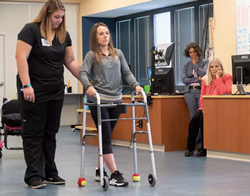Rachel Becker* says technology originally designed for pain management has enabled two people with paralysis to walk again, raising hopes for its wider use.

Photo: University of Louisville
After Kelly Thomas’s ute flipped with her inside it in 2014, she was told she would probably never walk again.
Now, with help from a spinal cord implant that she’s nicknamed “Junior,” Thomas (pictured) is able to walk on her own.
Thomas and Jeff Marquis, who was paralysed after a mountain biking accident, can now independently walk again after participating in a study at the University of Louisville published last week in the New England Journal of Medicine.
Thomas still needs a walker, but she also gained muscle and lost the nerve pain in her foot that has persisted since her accident.
For the millions of people who are paralysed because of spinal cord injuries, the hope is that standing and stepping can help bring more independence, improve circulation and bone density, and boost cardiovascular health.
“There’s no real treatment for people with this type of injury,” says Susan Harkema, Associate Director of the Kentucky Spinal Cord Injury Research Center at the University of Louisville and senior author of the Journal paper.
“This isn’t taking them back to before their injury, but it’s giving them significant, incremental return of function, and health — and that can make their daily lives substantially better.”
For Thomas, when she walked without help for the first time, “it was like watching fireworks, but from the inside,” she says.
“Something I was never supposed to do ever just happened. It was awesome.”
“There’s no other feeling like it in the world.”
The device that Thomas calls “Junior” is a 16-electrode array that delivers electrical stimulation to her spinal cord.
With intense training, the device has helped Thomas walk again.
The technique doesn’t work perfectly for everyone: two other study participants at the University of Louisville did not relearn how to walk, though they can now stand, hold their torsos upright, and move their legs.
But even a limited ability to walk comes with health benefits.
This is the first time anyone has demonstrated functional walking activity for a patient with complete spinal cord injury.
Thomas put her name down to participate in future research at the University of Louisville, and in November 2016, she got a call asking if she wanted to enrol in a study.
Thomas was torn.
She had already been doing extensive physical therapy and was able to stand up by then.
But there was a hitch: to participate, she’d have to undergo surgery to implant Junior.
“I didn’t want to lose anything that I’d worked so hard for,” she says.
“I had regained so much, and the surgery scared me.”
Junior is the Restore Advanced SureScan MRI Neurostimulator made by Medtronic, and it’s approved for pain management.
Thomas controls it with a remote that communicates through her skin to a hub in her abdomen.
“I have to have a remote to turn myself on and off, and when it’s off I’m completely paralysed,” she says.
“Whenever it’s on I can kick my legs out, I can walk, I can move my toes.”
It might sound a little strange to use a device for pain control to restore the ability to walk.
But animal research has shown that rats with spinal cord injuries can learn to step again with training, drugs, and spinal stimulation.
And people who are paralysed can make step-like movements while lying down with spinal cord stimulation.
So that hints that the parts of the spinal cord responsible for walking should still work in these patients.
“If you cut the head off a snake, the snake will keep moving — you can’t even tell it’s not controlled by the head,” says Reggie Edgerton, a professor of integrative biology and physiology at the University of California, Los Angeles.
“All of that is built into the spinal cord.”
The researchers are still investigating how this all works.
But one theory is that after a spinal cord injury, those spinal networks may lose the electrical charge and information they’re getting from the brain — although some weak connections may remain.
And that’s where the spinal stimulator comes in: the idea is that it essentially charges the spinal cord back up so that, with enough training and practise intending to move, Thomas’s body could relearn how to walk.
The key was learning to work with the stimulator, Thomas says.
She had to concentrate hard on moving her legs.
“It’s not a quick fix to being paralysed,” she says.
“You don’t turn it on and you’re just automatically back to where you were pre-injury.”
“You have to figure out how to use it, how to work with your body again.”
The researchers don’t know why it works so well for Thomas and Marquis, but less so for the others.
It could be differences between the study participants’ injuries, the training regimens, or the stimulation itself.
“We still don’t know,” Harkema says.
“We have to do larger trials.”
But before the team can do those larger trials, the tech needs to become more accessible.
Right now, the controllers have to be operated by hand, and hand function can be limited by spinal cord injuries, depending on the injury’s location.
So, a key step will be to make the stimulators voice-activated.
The tech exists, but applying it to a spinal stimulator takes investment from the tech sector, and that’s not in the researchers’ control, Harkema says.
These days, Thomas can walk with a walker, provided the stimulator’s on.
But her next goal is to improve her balance so she can ditch the walker altogether.
“If I lean too far forward, I may fall,” she says.
“That’s my next step, to figure out how to catch myself if I start to fall.”
* Rachel Becker is a science journalist for The Verge. She tweets at @RA_Becks and her website is rabecks.com.
This article first appeared at www.theverge.com.











